2) Department of Animal Production, Faculty of Agriculture, Al-Azhar University, Nasr City, Cairo 11884, Egypt;
3) CAS Key Laboratory of Marine Ecology and Environmental Sciences, Institute of Oceanology, Chinese Academy of Sciences, Qingdao 266000, China;
4) School of Engineering, Hangzhou Normal University, Hangzhou 311121, China;
5) Department of Marine Biology, Institute of Biological Sciences, University of Rostock, Rostock 18055, Germany;
6) East China Sea Fisheries Research Institute, Chinese Academy of Fishery Sciences, Shanghai 200090, China
Plastic products are widely used due to their low-price, lightweight, practicality, and durability (Su et al., 2022). However, due to excessive production, plastic pollution was also getting worse. Just in 2017, the global annual production of plastics reached 348 t (Abbasi et al., 2018). According to a report by the IUCN in 2017, 9.5 million tons of plastic waste were poured into the oceans annually. Plastic pieces made up 80% – 85% of all marine debris (Auta et al., 2017). These plastic wastes break down into smaller plastic debris under the action of solar energy, wind energy, and biodegradation. Plastic pellets with a size of less than 5 mm are defined as microplastics (MPs) (Thompson et al., 2004). With their small size, MPs can rapidly travel across a long distance with ocean currents and tidal action, leading to their widespread distribution in seawater (Qiu et al., 2015), inbound rivers (Munari et al., 2017), coastal zones (Claessens et al., 2011) and sediments, and they even can be found in bipolar (Kanhai et al., 2020) and deep seas (Van Cauwenberghe et al., 2013). At present, MP pollution has become an environmental and ecological problem with great concern.
A number of studies have reported worldwide ingestion of microplastics by marine wild fish and invertebrates, such as shrimps (Carreras-Colom et al., 2018), sharks (Alomar and Deudero, 2017) and mussels (Reguera et al., 2019). As one of the largest and most diverse animal groups on the planet, fish have undisputable, ecological and economic benefits (Bogutskaya, 2007), which increases the opportunity to come into contact with plastic marine debris and leads to further consequences. Currently, considerable cases of MP ingestion from a varied range of fish have been reported. In Hangzhou Bay, the average MP abundance in fishes was higher than those in crabs and shrimps, which may indicate that MPs have accumulated through the food chain in the local ecosystem (Wang et al., 2020); in the Gulf of Beibu, MPs were detected in 12 species of fish with an abundance of 0.027 – 1.000 items per individuals (Koongolla et al., 2020); in the Yangtze River Estuary Basin, MPs were found in all the 146 sampled fishes, and 98.9% of the foreign matter particles were MPs (Zhang et al., 2022). Habitat and diet may be two important factors in the fish ingestion of MPs (Su et al., 2019). Some studies have shown high levels of MPs in benthic fish, which may ingest plastic particles from the seabed (Possatto et al., 2011; Jabeen et al., 2017). The reason may be that the content of MPs settled in the bottom water body is high, which increases the chance of demersal fish eating MPs by mistake. The relevant studies have found that demersal fish inevitably ingest sediments during predation, leading to a generally high abundance of MPs in benthic organisms due to the higher abundance of MPs in sediment (Lusher et al., 2013). In the upper Gulf of Thailand and Mediterranean Sea, demersal fish have been found to have higher contamination rates than pelagic fishes (Compa et al., 2019; Cáceres-Farias et al., 2023). However, whether benthic environments play a key role in MP uptake is unclear, which may vary depending on the area surveyed. A large amount of buoyant plastics present on the sea surface is also thought to cause pelagic fish to ingest more MPs (Rummel et al., 2016). Regarding diet, herbivorous fish may have lower intake of MPs compared to omnivorous and carnivorous fish, due to their narrower dietary range and lower nutrient levels, which may reduce their likelihood of plastic ingestion (Mizraji et al., 2017).
Haizhou Bay is located on the western edge of the South Yellow Sea, with Arashiyama Port to the north and Lianyungang to the south. Haizhou Bay has a mid-latitude monsoon climate characterized by abundant sunshine and heavy rainfall. The waters in the bay are fertile and support many sedimentary species (Ai et al., 2023), including mackerel, striped fish, shrimp, seaweed and shellfish. Besides, due to favorable environmental conditions, the inner bay has become the largest growing area for Porphyra yezoensis (nori), accounting for about half of China's production (Gao et al., 2019). So far, little research on MP investigation in Haizhou Bay is reported, and it is urgent to study the distribution pattern and pollution status of MPs in Haizhou Bay. In this study, eight representative fish species with diverse feeding habits from different water layers were chosen for analysis of the amount and type of MPs present in their intestines. The primary aim of this study was to assess the intake of MPs by fish in Haizhou Bay and analyze the overall pollution level. The following specific issues were examined: 1) determining whether fish collected from different habitats in Haizhou Bay had ingested MPs; 2) identifying what polymers are present and what shapes, sizes, and colors they are; 3) assessing the difference in the levels of MPs ingested between pelagic and benthic species.
2 Materials and Methods 2.1 Sample Collection and PreparationFrom March to May 2021, eight species (4 benthic species: wing redfish (Lepidotrigla alata) (Houttuyn, 1782); largehead hairtail (Trichiurus lepturus) (Linnaeus, 1758); little yellow croaker (Larimichthys polyactis) (Bleeker, 1877) and lizardfish (Saurida elongata) (Aulopus Elongatus Temminck and Schlegel, 846) and 4 pelagic fish species: silver pomfret (Pampus argenteus) (Euphrasen, 1788); brown croaker (Miichthys miiuy) (Basilewsky, 1855); striped knifejaw (Oplegnathus fasciatus) (Kroyer, 1845) and Sphyraenus (Liza haematocheila) (Temminck and Schlegel, 1845) were collected from 16 sampling points in Haizhou Bay (Fig.1 and Table 1). At each station, the trawling operation was carried out at a rate of 2 – 2.4 knots for 30 – 45 min using an Agassiz trawl (2.2 m wide, 0.65 m high, 4 m long; mesh size 20 mm), and the trawl was thoroughly rinsed with local water after each operation. All fish samples were captured and quickly packed into bags made of aluminum foil to minimize air pollution. The fish samples were quick-frozen at −20℃ upon removal from the water and transported to the laboratory for further analysis.
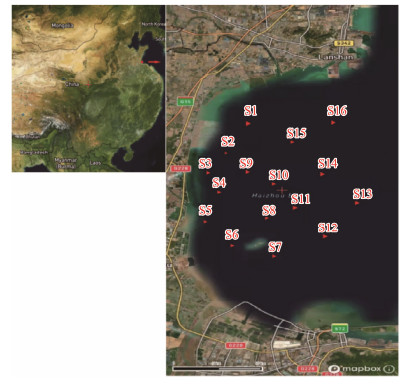
|
Fig. 1 Locations of the sampling region and fish sampling sites in the Haizhou Bay. |
|
|
Table 1 Summary of sampling regions and fish samples |
Fish samples were rinsed repeatedly with distilled water until the surfaces were clean. Once they were defrosted, their body length, weight, and quality were determined and recorded. Then, the intestinal tissues of the fish were dissected, weighed, and chopped with scissors. The chopped tissues were transferred to a glass bottle with marks for further identification and analysis of MPs. All the above experiments were under the National Institutes of Health Guide for the Care and Use of Laboratory Animals of China.
In this study, the procedure for plastic debris separation followed the recommended protocol described by Jabeen et al. (2017) with necessary modifications. Each intestine sample was put in a bottle with 300 mL potassium hydroxide (KOH, 10%, V/V) to digest biological tissues, then the bottle was covered with tin foil. The bottles were agitated continuously (80 r min−1) in an oscillation incubator at 60℃ for 48 h to accelerate the dissolution of organic matter.
When the digestion procedure was completed, 100 mL of saturated NaCl was added to each bottle. After thorough stirring, the bottles were left to sit for 24 h. Then, the digestion solution was filtered through a 1 μm glass fiber filter (WhatmanAE98). The residuals were placed in clean Petri dishes with lids and dried at 37℃ for further analysis (Pérez-Guevara et al., 2021).
The dried filter papers were first examined for potential MPs under a stereomicroscope at 50× magnification and identified accurately by Fourier-transformed infrared spectrometer (FTIR, Nicolet iN10) for the materials of MPs (Li et al., 2015). The plastics were classified based on their sizes, shapes (fiber, fragment, and pellet) and colors (transparent, black, red, yellow, green, and blue) (Li et al., 2016). Finally, the spectra of MPs identified by FTIR were compared with the spectral library in OMNIC Picta software for retrieval analysis, and the characteristic peaks of each functional group were combined to identify the polymer materials. The number of MPs was recalculated after excluding non-plastic items.
Suitable cleaning equipment is essential to obtain valid data reflecting the real MP pollution (Wesch et al., 2017). All the instruments, glass wares, and dissection tools were rinsed with filtered water at least three times before use and stored in covered containers. Procedural blanks were performed in parallel with fish samples (only pure water is present) to further limit the extent of MP contamination in the air (Zhang et al., 2022).
2.3 Statistical MethodThe detection rate of fish samples and the relative abundance of MPs were measured. The relative proportion of each type of MPs in each sample was calculated based on the statistical results of the MP types (shape, color, and size) isolated from each sample, and all diagrams were plotted by Origin 2021. Differences in relative abundance of MPs among eight different species of fish, as well as differences in MP abundance between fish with different habitats and feeding modes, were assessed by Kruskal-Wallis one-way ANOVA (Kang et al., 2015). At the 95% confidence interval, a significant difference was considered when P < 0.05. All data analysis was performed in SPSS v.26.3.
3 Results 3.1 MP Abundance in Different SpeciesIn the intestines of 97 out of 143 individuals from 8 species, MPs were detected, accounting for 67.83% of the samples (Tables 2 and 3). The detection rate of MPs in different fish species ranged from 53.33% to 80%. The average abundance of MPs in all fish was 0.06 items g−1, with a wide variation from 0.02 items g−1 in M. miiuy to 0.16 items g−1 in L. polyactis (Fig.2; Table 4).
|
|
Table 2 Summary of fish traits and the depth in habitats |
|
|
Table 3 Number of suspected microplastics |
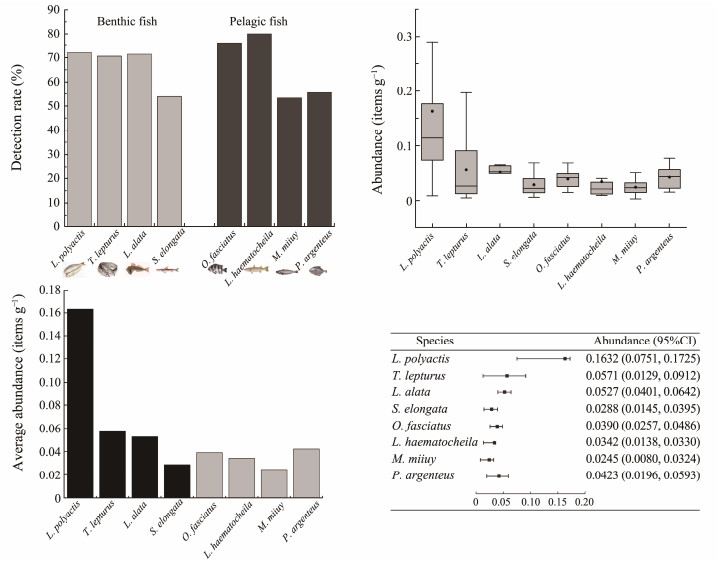
|
Fig. 2 Data summary, including the number and detection rate of microplastics in 8 fish species, and the abundance of MPs in each fish. |
|
|
Table 4 Abundance of MPs in each fish |
In terms of habitat and feeding habits, the abundance of MPs in the intestines of fish varies obviously (Fig.3). Benthic fish ingested significantly more MPs than pelagic fish (P < 0.05). In addition, the omnivorous fish appeared to ingest more MPs than the predators in this study (P < 0.05).
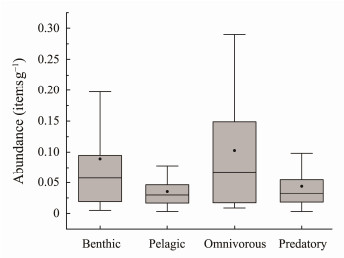
|
Fig. 3 Comparison of MP abundance of fish with different feeding behaviors from different habitats. |
The shape proportions of MPs were shown in Fig.4. In this study, fibers were the most common shape, followed by fragments and pellets. The average percentage of fiber occurrence was 73.32%. The proportions of fibers were 66.67% in P. argenteus, 75% in M. miiuy, 66.20% in L. alata, 66.67% in O. fasciatus, 85.29% in S. elongata, 80.56% in L. haematocheila, 64.13% in T. lepturus and 82.02% in L. polyactis. Pellets were detected in all eight species. Fragments were not found in M. miiuy. In particular, pellets accounted for less than 35% in each species and fragments for less than 10%. There was no significant difference in the occurrence of fibers and fragments among the eight species (P < 0.05). However, in terms of pellets, the MP concentration in L. polyacti was significantly lower than that in L. alata and O. fasciatus (P < 0.05); the MP concentration in L. alata was significantly higher than those in S. elongata and L. haematocheila (P < 0.05); and the MP concentration in O. fasciatus was significantly higher than that in L. haematocheila (P < 0.05).
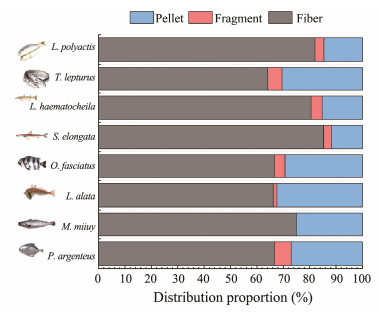
|
Fig. 4 Shape distribution of microplastics in eight species of fish from different sites. |
The size of MPs ranged from 0 to 5 mm in this study (Fig.5). The MPs smaller than 25 mm were the most abundant, accounting for 57.14% in P. argenteus, 62.50% in M. miiuy, 60.56% in L. alata, 53.33% in O. fasciatus, 47.06% in S. elongata, 38.89% in L. haematocheila, 56.52% in T. lepturus and 48.31% in L. polyactis, respectively.
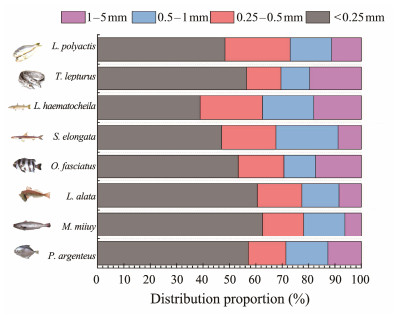
|
Fig. 5 Size distribution of microplastics by different color bars for eight species of fish from different sites in Haizhou Bay. |
The percentage of MPs categorized by color was also analyzed (Fig.6). The MPs in the eight species of fish were mainly black, which accounted for 52.38% in P. argenteus, 50% in M. miiuy, 60.56% in L. alata, 72% in O. fasciatus, 44.12% in S. elongata, 74.71% in L. haematocheila, 72.83% in T. lepturus and 69.66% in L. polyactis, respectively. Among them, the black MPs in O. fasciatus were significantly higher than those in S. elongata and M. miiuy (P < 0.05), which contained a small number of transparent MPs except for S. elongata and L. haematocheila. No green MPs were present in O. fasciatus and S. elongata.
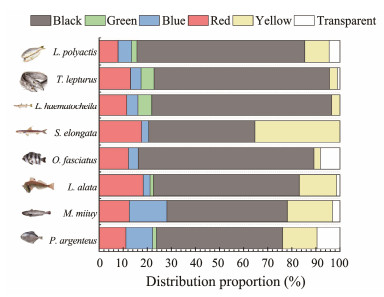
|
Fig. 6 Color distribution of microplastics in eight species of fish from different sites in the Haizhou Bay. |
In the polymer, PET, PA, and PS comprised 81.2% of total MPs by number, with respective proportions of 34.9%, 29.9%, and 16.4% (Fig.7).
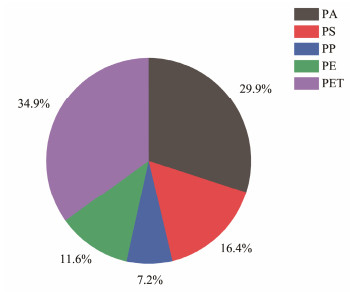
|
Fig. 7 Material composition distribution. |
The reference polymer and the matching characteristic spectral assignments were shown in Fig.8. MP materials were subsequently confirmed by using μ-FT-IR. The results showed that the MP polymers ranked in order of proportion as polyamide (PA), polyethylene terephthalate (PET), polystyrene (PS), Polyethylene (PE) Polypropylene (PP) and other unknown organic compounds, which may represent a common MP source (Fig.8). PET was the predominant polymer in P. argenteus (33.33%), L. alata (40.63%), O. fasciatus (44%), L. haematocheila (33.33%) and L. polyactis (41.57%), respectively. PA was the second most abundant in M. miiuy (32.39%), S. elongata (38.24%), and T. lepturus (41.30%), respectively (Fig.9). In addition, a small amount of PP (7.2%) was also identified.
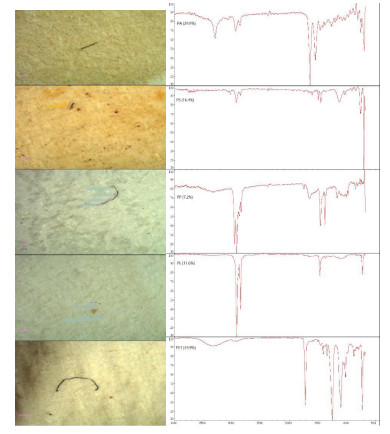
|
Fig. 8 Examples of microplastics found in the intestine tract of fish, representing the most abundant polymer types and material spectra identified by μ-FTIR microscope. |
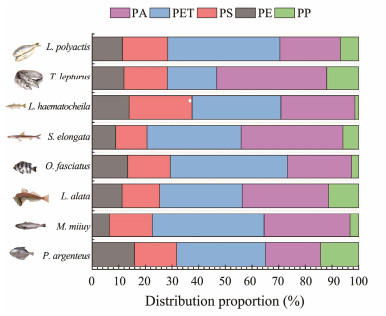
|
Fig. 9 Percentage of microplastics categorized by composition materials extracted from the eight fish species along the Haizhou Bay. |
In the analysis of MP abundance in fishes from different habitats, we found no significant difference in MP characteristics between benthic and pelagic fish (P > 0.05). However, there were significant differences among the fish with different feeding modes in terms of MP characteristics such as size, shape and material (Fig.10): predatory fish mainly ingested MPs < 0.25 mm, which was significantly higher than that of omnivorous fish (P = 0.014 < 0.05). Similar differences were also found in pellet MPs ingested by predatory fish (27.8%) and omnivorous fish (14.9%) (P = 0.010 < 0.05). PA (31.4%) and PP (9%) ingested by predatory fish were significantly higher than PA (25%) (P = 0.013 < 0.05) and PP (4.4%) ingested by omnivorous fish (P = 0.044 < 0.05).
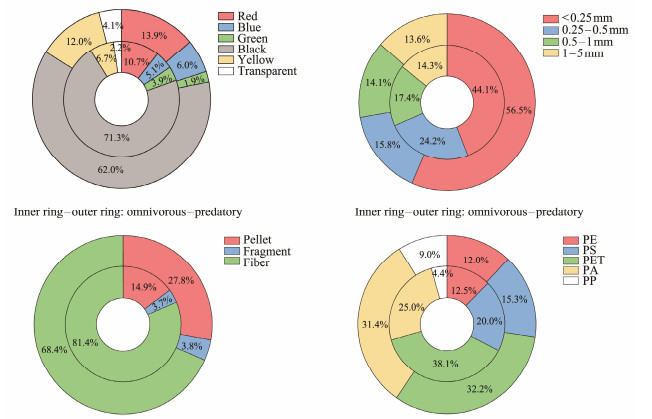
|
Fig. 10 Characteristic analysis of color, size, shape, and components in different feeding fish. |
Large number of MPs would accumulate easily due to the semi-enclosed natural geographical environment of the bay (Xue et al., 2020). In this experiment, the detection rates of MPs varied greatly among different fish species, among which fish L. haematocheila had the highest detection rate (80.0%) and M. miiuy had the lowest (53.33%).
The average detection rate of MPs in fish in Haizhou Bay was 67.83%, which is relatively high compared to previous studies in the Texas Gulf Coast (42%) (Peters et al., 2017), the English Channel (36.50%) (Lusher et al., 2013), southern Australia (35.5%) (Wootton et al., 2021), the remote Xisha areas of the South China Sea (29.3%) (Huang et al., 2023) and eastern Coast of Thailand (13.14%) (Phaksopa et al., 2021). But it is far lower than that in fish from South African coastal (86.67%) (Sparks and Immelman, 2020), South Africa (92.3%) (Dahms et al., 2022), Northwest Peninsular Malaysia (100%) (Foo et al., 2022), western Amazonia (100%) (Rojas et al., 2023) and coral reef fish in the South China Sea (83.90%) (Ding et al., 2019). Overall, the results of this experiment showed that MP pollution of Haizhou Bay reached a medium level.
The results of this study highlight the seriousness of MP pollution in Haizhou Bay. As is well known, rivers are the primary pathway through which MPs can enter the oceans nearby (Simon-Sánchez et al., 2019; van Wijnen et al., 2019). As one of the largest land-based rivers, the cumulative amount of domestic sewage and industrial wastewater discharged to Haizhou Bay reached 2.26 × 108 t in 2010, a significant portion of which is comprised of plastic waste (Feng et al., 2019). Moreover, there are a large number of plastic marine aquaculture facilities in Haizhou Bay, and these facilities have become to be an important source of MPs due to the increasing wear and tear. In addition, the Haizhou Bay area belongs to a semi-open environment, the wind and waves are relatively small, and it is easy to settle MPs (Koongolla et al., 2020).
4.2 Abundance of Microplastics in Different Fish SpeciesIn this study, MPs were detected in all 8 species of fish, regardless of habitat and feeding mode, indicating that MPs were prevalent in Haizhou Bay. In terms of living habitats, the abundance of MPs in benthic fish was significantly higher than that of pelagic fish. L. polyactis, a typical benthic fish, ingested the MPs at a level of 0.16 items g−1, which was significantly higher than the other fish (P < 0.05). With the extensive use of plastics, a growing number of MPs have entered and accumulated in the ocean, including the deep sea (Van Cauwenberghe and Janssen, 2014; Bergmann et al., 2017; Courtene-Jones et al., 2017). Four of the eight species of fish belong to benthic species, among which L. polyactis and T. lepturus had the highest MP ingestion. In a study of MP intake by deep-sea fish in the South China Sea, Chlorophthalmus albatrossis and Diaphus watasei were found to have high levels of MP ingestion (Zhu et al., 2019), which came from deeper water layers (Tucker, 1953; Sakaji et al., 2006). These studies indicate that the high abundance of MPs in benthic species may come from the ingestion of MPs on the seafloor (Possatto et al., 2011; Foekema et al., 2013; Collard et al., 2015), and seafloor habitats could be a rallying point for MPs (Alomar and Deudero, 2017). However, as pelagic fish, O. fasciatus and L. haematocheila also showed a large number of MP intake. This validates the statement that the mass buoyancy action on MPs of seawater can cause pelagic species to touch with large amounts of suspended MPs (Fossi et al., 2014; Romeo et al., 2015). Therefore, whether ecological habitats play a key role in MP ingestion remains a question that requires long-term investigation.
On the other hand, the feeding behavior of fish can regulate their MP ingestion (Yu et al., 2022). Compared to predatory fish, omnivorous fish ingest relatively fewer MPs by feeding on food particles from the environment (Huang et al., 2020). But in this study, two kinds of omnivorous fish (L. haematocheila and L. polyactis) also ingested MPs in all sampling sites. Omnivorous fish usually feed on plankton and organic detritus in the water. Because of the similar size, they may consume MPs by mistake. It may also be possible that the estuary, where they live, is usually rich in MPs (Lin et al., 2018; Nel et al., 2018). Predatory fish also ingested high-level MPs in this study. Unlike omnivorous fish, predatory fish may accumulate MPs through the food chain, as their prey, such as some small benthic fish and mollusks, can also ingest MPs (Romeo et al., 2015). In addition, the complex digestive tract structure of predatory fish favors their attachment and retention of MP particles (Jabeen et al., 2017).
4.3 Characteristics of Microplastics in the Intestine of FishAmong the MPs with different sizes surveyed in this study, the MPs with a size of less than 0.25 mm were the most abundant. Previous studies indicated that small-size MPs are the most common (Zhao et al., 2014; Li et al., 2016; Peng et al., 2016; Ding et al., 2019). There are different sizes of MPs in different marine animals, which are related to the biological characteristics of marine animals. As far as the eight types of fish in Haizhou Bay were concerned, with the increase in particle size, the abundance of MPs tends to decrease. In terms of feeding modes, predatory fish were found to be more likely to ingest small MPs (< 0.25 mm) than omnivorous fish in this study, which may be due to secondary intake of MPs from their prey (Romeo et al., 2015), or the ingestion of MPs by the unconscious feeding behavior (Lusher et al., 2013). Some large plastics are gradually fragmented into smaller MPs under the mechanical effects, photooxidation, and biodegradation in the ocean (Berit et al., 2015). Thus, the number of small MP fragments increases geometrically as their sizes gradually decrease (Isobe et al., 2015), making them easier to be ingested by fish and accumulate in tissues (Browne et al., 2008). Researchers have already found that the poisonousness of MP particles depends on the size, and smaller granules are more noxious to marine zooplankton than larger granules (Lee et al., 2013; Jeong et al., 2016). Generally, it is necessary to assess the hazards posed by counting the number of small MPs in enclosed bays.
Black MPs accounted for 50.0% – 74.71% of the MPs in the fish samples, followed by red and yellow. MPs of other colors (transparent, blue, and green) occupied a small proportion, whatever the feeding modes or habitats are. In the natural environment, black MPs have been found as the most common ones in Haizhou Bay, which was consistent with the findings in the English Channel (Lusher et al., 2013) and the Yellow Sea Wetlands (Feng et al., 2020), implying that they have the similar sources. The reason for this result may be that predators preferably ingest plastic that is similar in color to their prey. Plastic equipment, nets and gear used in fishing activities may be some of the sources of black plastics in the study systems (Abayomi et al., 2017). And white MPs can come from plastic sheets (Bugoni et al., 2001), and blue nylon fibers are common, which were used as cables in fishing activities (Possatto et al., 2011).
The majority of studies have suggested that fibers may be the main type of MPs in the ocean (Woodall et al., 2014; Frias et al., 2016; Taylor et al., 2016; Sun et al., 2018). Elongated fibers may resemble zooplankton and lead to massive ingestion (Nie et al., 2019). This could explain the great number of MPs ingested by the fish in this study. Interestingly, we found that predatory fish had a significantly higher proportion of MPs in the shape of pellets than omnivorous fish. This may be because predators can actively catch plastic pellet that looks like food particles (Ory et al., 2017). Marine plastic debris is a major source of plastic pollution (Possatto et al., 2011) for the high use of plastic fishing tools such as nets, gears, and ropes, which were connected with the rich fishery resources of Haizhou Bay. Furthermore, Haizhou Bay has the largest highquality beach in China. The tourism industry is one of the main sources of MPs. In terms of components, PET and PA were the two dominant polymer types. PET is extensively used for food packages, medicine packages, nontoxic and sterile packaging materials, agricultural film, plastic bottles, and most frequently plastic bags. PA is known as nylon, which has been widely used in fishing gear and other material manufacture. They were often detected in marine environments (Zhang et al., 2015; Munari et al., 2017), as in this study.
4.4 Potential Hazards of MP Pollution in Haizhou BayThe Haizhou Bay area has undergone large-scale urban and port construction along the coast, discharging large quantities of pollutants such as persistent organic pollutants and heavy metals, which created an adsorption environment for MPs (Zhang et al., 2015; Chen et al., 2017). Previous studies have shown that MPs can be physically and physiologically harmful to marine life (Derraik, 2002; Bhattacharya et al., 2010), including appetite reduction, blockage of the intestine, internal physical damage, and interference with metabolism (Jambeck et al., 2015; Lu et al., 2016). Thus, the combined impacts of MPs and pollutants in Haizhou Bay should be paid more attention.
Due to condition limitations (the particles below the measurable level are uniformly defined as < 0.25 mm in this study), we only investigate the MPs in the fish intestine. However, in other studies, researchers have found MPs in liver and muscle tissues (Collard et al., 2017; Akhbarizadeh et al., 2018), which may indicate that the MPs can transfer from the gut to the circulatory system and may harm to the whole body. Therefore, the other tissues will also need to be examined (Besseling et al., 2014).
Haizhou Bay is adjacent to the Yellow Sea in the east, and the concentration of nutrients is high. So, the plankton containing MPs is abundant in this area, which may be ingested by the fish (Lin et al., 2004) and pose the risk of MP accumulation in the fish. In addition, our results indicated that the number of MPs in fish intestines is at a moderate level at the sampling site, which has already threatened vulnerable young fishery species and led to a reduction in fishery resources. Of course, the flow direction of MPs needs to be further studied, as once they are transferred to a higher level of nutrition, they will eventually pose a threat to human health (Paul-Pont et al., 2016; Pellini et al., 2018). So, we will conduct studies on MP enrichment in other benthic animals (including economic shellfish and shrimp) in Haizhou Bay in the future. In brief, further assessment of MP pollution in Haizhou Bay should be a priority for future research.
5 ConclusionsThe pollution of MPs has spread to the bay. In this study, Haizhou Bay was taken as a case, and we selected 8 typical economic fish species in the bay to identify and quantify MPs in the fish intestines. In a word, the abundance of MP intake varied from 0.02 items g−1 to 0.16 items g−1 and the detection rate of MPs ranged from 53.33% to 80%, which showed a medium pollution level. The MP intake in benthic fish and omnivorous fish was significantly higher than that of pelagic fish and predatory fish. The main MPs were < 0.25 mm in size, fiber in shape, black in color, and PET or PA in the composition materials.
As a typical semi-enclosed bay, MP pollution in Haizhou Bay mainly comes from human activities, including aquaculture and engineering construction. If MPs continue to increase, it will lead to the reduction in fishery production and the accumulation of MPs in fish intestines, eventually threatening human health. Controlling the use of plastics from the source is a necessary measure to reduce MPs pollution, and research on the MPs in Haizhou Bay should also be further strengthened.
AcknowledgementsThis study was funded by research grants from the National Natural Science Foundation of China (Nos. 41706142 and 32071615), the China Agriculture Research System of MOF and MARA (No. CARS-49), and the Funding for School-Level Research Projects of Yancheng Institute of Technology (No. XJR2021035). Yanming Sui is supported by a fellowship from the China Scholarship Council.
Author Contributions
All authors contributed to the study conception and design. Material preparation, data collection and analysis were performed by Yanming Sui, Linlan Lv, Liang Zheng, Mohsen Mohamed, Yebing Yu and Zhiquan Liu. The draft of the manuscript was written by Yingying Zhang, Shihao Chen, Yangyang Shi, Jiaxin Zou and Kunyun Qin, and all authors commented on previous versions of the manuscript. All authors read and approved the final manuscript.
Data Availability
The data and references presented in this study are available from the corresponding author upon reasonable request.
Declarations
Ethics Approval and Consent to Participate
This article does not contain any studies with human participants or animals performed by any of the authors.
Consent for Publication
Informed consent for publication was obtained from all participants.
Conflict of Interests
The authors declare that they have no conflict of interests.
Abayomi, O. A., Range, P., Al-Ghouti, M. A., and Obbard, J. P., 2017. Microplastics in coastal environments of the Arabian Gulf. Marine Pollution Bulletin, 124(1): 181-188. DOI:10.1016/j.marpolbul.2017.07.011 (  0) 0) |
Abbasi, S., Soltani, N., Keshavarzi, B., Moore, F., Turner, A., and Hassanaghaei, M., 2018. Microplastics in different tissues of fish and prawn from the Musa Estuary, Persian Gulf. Chemosphere, 205: 80-87. DOI:10.1016/j.chemosphere.2018.04.076 (  0) 0) |
Ai, B., Wang, P., Yang, Z., Tian, Y., and Liu, D., 2023. Spatiotemporal dynamics analysis of aquaculture zones and its impact on green tide disaster in Haizhou Bay, China. Marine Environmental Research, 183: 105825. DOI:10.1016/j.marenvres.2022.105825 (  0) 0) |
Akhbarizadeh, R., Moore, F., and Keshavarzi, B., 2018. Investigating a probable relationship between microplastics and potentially toxic elements in fish muscles from northeast of Persian Gulf. Environmental Pollution, 232: 154-163. DOI:10.1016/j.envpol.2017.09.028 (  0) 0) |
Alomar, C., and Deudero, S., 2017. Evidence of microplastic ingestion in the shark Galeus melastomus Rafinesque, 1810 in the continental shelf off the western Mediterranean Sea. Environmental Pollution, 223: 223-229. DOI:10.1016/j.envpol.2017.01.015 (  0) 0) |
Auta, H. S., Emenike, C. U., and Fauziah, S. H., 2017. Distribution and importance of microplastics in the marine environment: A review of the sources, fate, effects, and potential solutions. Environment International, 102: 165-176. DOI:10.1016/j.envint.2017.02.013 (  0) 0) |
Bergmann, M., Wirzberger, V., Krumpen, T., Lorenz, C., Primpke, S., Tekman, M. B., et al., 2017. High quantities of microplastic in Arctic deep-sea sediments from the HAUSGARTEN observatory. Environmental Science & Technology, 51(19): 11000-11010. DOI:10.1016/j.marpolbul.2017.08.016 (  0) 0) |
Berit, G., Plassmann, M. M., and MacLeod, M., 2015. Pathways for degradation of plastic polymers floating in the marine environment. Environmental Science, 17: 1513-1521. DOI:10.1039/c5em00207a (  0) 0) |
Besseling, E., Wang, B., Lürling, M., and Koelmans, A. A., 2014. S. obliquus and reproduction of D. magna. Environmental Science & Technology, 48(20): 12336-12343. DOI:10.1021/es503001d (  0) 0) |
Bhattacharya, P., Lin, S., Turner, J. P., and Ke, P. C., 2010. Physical adsorption of charged plastic nanoparticles affects algal photosynthesis. The Journal of Physical Chemistry, 114(39): 16556-16561. DOI:10.1021/jp1054759 (  0) 0) |
Bogutskaya, N., 2007. Book review. Fishes of the World. 4th edition. Zoosystematica Rossica, 15: 342. DOI:10.31610/zsr/2006.15.2.342 (  0) 0) |
Browne, M. A., Dissanayake, A., Galloway, T., Lowe, D. M., and Thompson, R. C., 2008. Ingested microscopic plastic translocates to the circulatory system of the mussel, Mytilus edulis. Environmental Science & Technology, 42(13): 5026-5031. DOI:10.1021/es800249a (  0) 0) |
Bugoni, L., Krause, L., and Petry, M. V., 2001. Marine debris and human impacts on sea turtles in southern Brazil. Marine Pollution Bulletin, 42(12): 1330-1334. DOI:10.1016/S0025-326X(01)00147-3 (  0) 0) |
Cáceres-Farias, L., Espinoza-Vera, M. M., Orós, J., Garcia-Bereguiain, M. A., and Alfaro-Núñez, A., 2023. Macro and microplastic intake in seafood variates by the marine organism's feeding behaviour: Is it a concern to human health?. Heliyon, 9(5): 16452. DOI:10.1016/j.heliyon.2023.e16452 (  0) 0) |
Carreras-Colom, E., Constenla, M., Soler-Membrives, A., Cartes, J. E., Baeza, M., Padrós, F., et al., 2018. Spatial occurrence and effects of microplastic ingestion on the deep-water shrimp Aristeus antennatus. Marine Pollution Bulletin, 133: 44-52. DOI:10.1016/j.marpolbul.2018.05.012 (  0) 0) |
Chen, Q., Yin, D., Jia, Y., Schiwy, S., Legradi, J., Yang, S., et al., 2017. Enhanced uptake of BPA in the presence of nanoplastics can lead to neurotoxic effects in adult zebrafish. Science of the Total Environment, 609: 1312-1321. DOI:10.1016/j.scitotenv.2017.07.144 (  0) 0) |
Claessens, M., Meester, S. D., Landuyt, L. V., Clerck, K. D., and Janssen, C. R., 2011. Occurrence and distribution of microplastics in marine sediments along the Belgian coast. Marine Pollution Bulletin, 62(10): 2199-2204. DOI:10.1016/j.marpolbul.2011.06.030 (  0) 0) |
Collard, F., Gilbert, B., Compère, P., Eppe, G., Das, K., Jauniaux, T., et al., 2017. Microplastics in livers of European anchovies (Engraulis encrasicolus, L.). Environmental Pollution, 229: 1000-1005. DOI:10.1016/j.envpol.2017.07.089 (  0) 0) |
Collard, F., Gilbert, B., Eppe, G., Parmentier, E., and Das, K., 2015. Detection of anthropogenic particles in fish stomachs: An isolation method adapted to identification by Raman spectroscopy. Archives of Environmental Contamination & Toxicology, 69(3): 331-339. DOI:10.1007/s00244-015-0221-0 (  0) 0) |
Compa, M., Alomar, C., Wilcox, C., Van Sebille, E., Lebreton, L., Hardesty, B. D., et al., 2019. Risk assessment of plastic pollution on marine diversity in the Mediterranean Sea. Science of the Total Environment, 678: 188-196. DOI:10.1016/j.scitotenv.2019.04.355 (  0) 0) |
Courtene-Jones, W., Quinn, B., Gary, S. F., Mogg, A. O. M., and Narayanaswamy, B. E., 2017. Microplastic pollution identified in deep-sea water and ingested by benthic invertebrates in the Rockall Trough, North Atlantic Ocean. Environmental Pollution, 231: 271-280. DOI:10.1016/j.envpol.2017.08.026 (  0) 0) |
Dahms, H. T. J., Tweddle, G. P., and Greenfield, R., 2022. Gastric microplastics in Clarias gariepinus of the upper Vaal River, South Africa. Frontiers in Environmental Science, 10: 931073. DOI:10.3389/fenvs.2022.931073 (  0) 0) |
Derraik, J. G. B., 2002. The pollution of the marine environment by plastic debris: A review. Marine Pollution Bulletin, 44(9): 842-852. DOI:10.1016/S0025-326X(02)00220-5 (  0) 0) |
Ding, J., Jiang, F., Li, J., Wang, Z., Sun, C., Wang, Z., et al., 2019. Microplastics in the coral reef systems from Xisha Islands of South China Sea. Environmental Science & Technology, 53(14): 8036-8046. DOI:10.1021/acs.est.9b01452 (  0) 0) |
Feng, Z., Wang, R., Zhang, T., Wang, J., Huang, W., Li, J., et al., 2020. Microplastics in specific tissues of wild sea urchins along the coastal areas of northern China. Science of the Total Environment, 728: 138660. DOI:10.1016/j.scitotenv.2020.138660 (  0) 0) |
Feng, Z., Zhang, T., Li, Y., He, X., Wang, R., Xu, J., et al., 2019. The accumulation of microplastics in fish from an important fish farm and mariculture area, Haizhou Bay, China. Science of the Total Environment, 696: 133948. DOI:10.1016/j.scitotenv.2019.133948 (  0) 0) |
Foekema, E., Gruijter, C., Mergia, M., Van Franeker, J., and Koelmans, A., 2013. Plastic in North Sea fish. Environmental Science & Technology, 47(15): 8818-8824. (  0) 0) |
Foo, Y. H., Ratnam, S., Lim, E. V., Abdullah, M., Molenaar, V. J., Hwai, A. T. S., et al., 2022. Microplastic ingestion by commercial marine fish from the seawater of Northwest Peninsular Malaysia. PeerJ, 10: 13181. (  0) 0) |
Fossi, M. C., Coppola, D., Baini, M., Giannetti, M., Guerranti, C., Marsili, L., et al., 2014. Large filter feeding marine organisms as indicators of microplastic in the pelagic environment: The case studies of the Mediterranean basking shark (Cetorhinus maximus) and fin whale (Balaenoptera physalus). Marine Environmental Research, 100: 17-24. DOI:10.1016/j.marenvres.2014.02.002 (  0) 0) |
Frias, J. P. G. L., Gago, J., Otero, V., and Sobral, P., 2016. Microplastics in coastal sediments from southern Portuguese shelf waters. Marine Environmental Research, 114: 24-30. DOI:10.1016/j.marenvres.2015.12.006 (  0) 0) |
Gao, G., Gao, Q., Bao, M., Xu, J., and Li, X., 2019. Nitrogen availability modulates the effects of ocean acidification on biomass yield and food quality of a marine crop Pyropia yezoensis. Food Chemistry, 271: 623-629. DOI:10.1016/j.foodchem.2018.07.090 (  0) 0) |
Huang, J. S., Koongolla, J. B., Li, H. X., Lin, L., Pan, Y. F., Liu, S., et al., 2020. Microplastic accumulation in fish from Zhanjiang mangrove wetland, South China. Science of the Total Environment, 708: 134839. DOI:10.1016/j.scitotenv.2019.134839 (  0) 0) |
Huang, L., Li, Q. P., Li, H. X., Lin, L., Xu, X. R., Yuan, X. J., et al., 2023. Microplastic contamination in coral reef fishes and its potential risks in the remote Xisha areas of the South China Sea. Marine Pollution Bulletin, 186: 114399. DOI:10.1016/j.marpolbul.2022.114399 (  0) 0) |
Isobe, A., Uchida, K., Tokai, T., and Iwasaki, S., 2015. East Asian seas: A hot spot of pelagic microplastics. Marine Pollution Bulletin, 101(2): 618-623. DOI:10.1016/j.marpolbul.2015.10.042 (  0) 0) |
Jabeen, K., Su, L., Yang, D., Tong, C., Mu, J., and Shi, H., 2017. Microplastics and mesoplastics in fish from coastal and fresh waters of China. Environmental Pollution, 221: 141-149. DOI:10.1016/j.envpol.2016.11.055 (  0) 0) |
Jambeck, J. R., Geyer, R., Wilcox, C., Siegler, T. R., Perryman, M., Andrady, A., et al., 2015. Plastic waste inputs from land into the ocean. Science, 347(6223): 768-771. DOI:10.1126/science.1260352 (  0) 0) |
Jeong, C. B., Won, E. J., Kang, H. M., Lee, M. C., Hwang, D. S., Hwang, U. K., et al., 2016. Microplastic size-dependent toxicity, oxidative stress induction, and p-JNK and p-p38 activation in the monogonont rotifer (Brachionus koreanus). Environmental Science & Technology, 50(16): 8849-8857. DOI:10.1021/acs.est.6b01441 (  0) 0) |
Kang, J. H., Kwon, O. Y., and Shim, W. J., 2015. Potential threat of microplastics to zooplanktivores in the surface waters of the southern sea of Korea. Archives of Environmental Contamination & Toxicology, 69(3): 340-351. DOI:10.1007/s00244-015-0210-3 (  0) 0) |
Kanhai, L. D. K., Gardfeldt, K., Krumpen, T., Thompson, R. C., and O'Connor, I., 2020. Microplastics in sea ice and seawater beneath ice floes from the Arctic Ocean. Scientific Reports, 10(1): 5004. DOI:10.1038/s41598-020-61948-6 (  0) 0) |
Koongolla, J. B., Lin, L., Pan, Y. F., Yang, C. P., Sun, D. R., Liu, S., et al., 2020. Occurrence of microplastics in gastrointestinal tracts and gills of fish from Beibu Gulf, South China Sea. Environmental Pollution, 258: 113734. DOI:10.1016/j.envpol.2019.113734 (  0) 0) |
Lee, K. W., Shim, W. J., Kwon, O. Y., and Kang, J. H., 2013. Sizedependent effects of micro polystyrene particles in the marine copepod Tigriopus japonicus. Environmental Science & Technology, 47(19): 11278-11283. DOI:10.1021/es401932b (  0) 0) |
Li, J., Qu, X., Su, L., Zhang, W., Yang, D., Kolandhasamy, P., et al., 2016. Microplastics in mussels along the coastal waters of China. Environmental Pollution, 214: 177-184. DOI:10.1016/j.envpol.2016.04.012 (  0) 0) |
Li, J., Yang, D., Li, L., Jabeen, K., and Shi, H., 2015. Microplastics in commercial bivalves from China. Environmental Pollution, 207: 190-195. DOI:10.1016/j.envpol.2015.09.018 (  0) 0) |
Lin, C., Ning, X., Su, J., Lin, Y., and Xu, B., 2004. Environmental changes and the responses of the ecosystems of the Yellow Sea during 1976 – 2000. Journal of Marine Systems, 55(3-4): 223-234. DOI:10.1016/j.jmarsys.2004.08.001 (  0) 0) |
Lin, L., Zuo, L. Z., Peng, J. P., Cai, L. Q., Fok, L., Yang, Y., et al., 2018. Occurrence and distribution of microplastics in an urban river: A case study in the Pearl River along Guangzhou City, China. Science of the Total Environment, 644: 375-381. DOI:10.1016/j.scitotenv.2018.06.327 (  0) 0) |
Lu, Y., Zhang, Y., Deng, Y., Jiang, W., Zhao, Y., Geng, J., et al., 2016. Uptake and accumulation of polystyrene microplastics in zebrafish (Danio rerio) and toxic effects in liver. Environmental Science & Technology, 50(7): 4054-4060. DOI:10.1021/acs.est.6b00183 (  0) 0) |
Lusher, A. L., Mchugh, M., and Thompson, R. C., 2013. Occurrence of microplastics in the gastrointestinal tract of pelagic and demersal fish from the English Channel. Marine Pollution Bulletin, 67(1-2): 94-99. DOI:10.1016/j.marpolbul.2012.11.028 (  0) 0) |
Mizraji, R., Ahrendt, C., Perez-Venegas, D., Vargas, J., Pulgar, J., Aldana, M., et al., 2017. Is the feeding type related with the content of microplastics in intertidal fish gut?. Marine Pollution Bulletin, 116(1-2): 498-500. DOI:10.1016/j.marpolbul.2017.01.008 (  0) 0) |
Munari, C., Scoponi, M., and Mistri, M., 2017. Plastic debris in the Mediterranean Sea: Types, occurrence and distribution along Adriatic shorelines. Waste Management, 67: 385-391. DOI:10.1016/j.wasman.2017.05.020 (  0) 0) |
Nel, H. A., Dalu, T., and Wasserman, R. J., 2018. Sinks and sources: Assessing microplastic abundance in river sediment and deposit feeders in an Austral temperate urban river system. Science of the Total Environment, 612: 950-956. DOI:10.1016/j.scitotenv.2017.08.298 (  0) 0) |
Nie, H., Wang, J., Xu, K., Huang, Y., and Yan, M., 2019. Microplastic pollution in water and fish samples around Nanxun Reef in Nansha Islands, South China Sea. Science of the Total Environment, 696: 134022. DOI:10.1016/j.scitotenv.2019.134022 (  0) 0) |
Ory, N. C., Sobral, P., Ferreira, J. L., and Thiel, M., 2017. Amberstripe scad Decapterus muroadsi (Carangidae) fish ingest blue microplastics resembling their copepod prey along the coast of Rapa Nui (Easter Island) in the South Pacific subtropical gyre. Science of the Total Environment, 586: 430-437. DOI:10.1016/j.scitotenv.2017.01.175 (  0) 0) |
Paul-Pont, I., Lacroix, C., Fernández, C. G., Hégaret, H., Lambert, C., Goïc, N. L., et al., 2016. Exposure of marine mussels Mytilus spp. to polystyrene microplastics: Toxicity and influence on fluoranthene bioaccumulation. Environmental Pollution, 216: 724-737. DOI:10.1016/j.envpol.2016.06.039 (  0) 0) |
Pellini, G., Gomiero, G. P. A., Fortibuoni, T., Ferrà, C., Grati, F., Tassetti, A. N., et al., 2018. Characterization of microplastic litter in the gastrointestinal tract of Solea solea from the Adriatic Sea. Environmental Pollution, 234: 943-952. DOI:10.1016/j.envpol.2017.12.038 (  0) 0) |
Peng, G., Zhu, B., Yang, D., Su, L., Shi, H., and Li, D., 2016. Microplastics in sediments of the Changjiang Estuary, China. Environmental Pollution, 225: 283-290. DOI:10.1016/j.envpol.2016.12.064 (  0) 0) |
Pérez-Guevara, F., Kutralam-Muniasamy, G., and Shruti, V. C., 2021. Critical review on microplastics in fecal matter: Research progress, analytical methods and future outlook. Science of the Total Environment, 778: 146395. DOI:10.1016/j.scitotenv.2021.146395 (  0) 0) |
Peters, C. A., Thomas, P. A., Rieper, K. B., and Bratton, S. P., 2017. Foraging preferences influence microplastic ingestion by six marine fish species from the Texas Gulf Coast. Marine Pollution Bulletin, 124(1): 82-88. DOI:10.1016/j.marpolbul.2017.06.080 (  0) 0) |
Phaksopa, J., Sukhsangchan, R., Keawsang, R., Tanapivattanakul, K., Thamrongnawasawat, T., Worachananant, S., et al., 2021. Presence and characterization of microplastics in coastal fish around the eastern coast of Thailand. Sustainability, 13(23): 132313110. (  0) 0) |
Possatto, F. E., Barletta, M., Costa, M. F., Sul, J. A. I., and Dantas, D. V., 2011. Plastic debris ingestion by marine catfish: An unexpected fisheries impact. Marine Pollution Bulletin, 62(5): 1098-1102. DOI:10.1016/j.marpolbul.2011.01.036 (  0) 0) |
Qiu, Q., Peng, J., Yu, X., Chen, F., Wang, J., and Dong, F., 2015. Occurrence of microplastics in the coastal marine environment: First observation on sediment of China. Marine Pollution Bulletin, 98(1-2): 274-280. DOI:10.1016/j.marpolbul.2015.07.028 (  0) 0) |
Reguera, P., Viñas, L., and Gago, J., 2019. Microplastics in wild mussels (Mytilus spp.) from the north coast of Spain. Scientia Marina, 83(4): 337-347. DOI:10.3989/scimar.04927.05A (  0) 0) |
Rojas, R. R., Arango-mora, C., Nolorbe-payahua, C., Medina, M., Vasquez, M., Flores, J., et al., 2023. Microplastic occurrence in fish species from the Iquitos region in Peru, western Amazonia. Acta Amazonica, 53(1): 65-72. DOI:10.1590/1809-4392202201212 (  0) 0) |
Romeo, T., Pietro, B., Pedà, C., Consoli, P., Andaloro, F., and Fossi, M. C., 2015. First evidence of presence of plastic debris in stomach of large pelagic fish in the Mediterranean Sea. Marine Pollution Bulletin, 95(1): 358-361. DOI:10.1016/j.marpolbul.2015.04.048 (  0) 0) |
Rummel, C. D., Löder, M. G. J., Fricke, N. F., Lang, T., Griebeler, E. M., Janke, M., et al., 2016. Plastic ingestion by pelagic and demersal fish from the North Sea and Baltic Sea. Marine Pollution Bulletin, 102(1): 134-141. DOI:10.1016/j.marpolbul.2015.11.043 (  0) 0) |
Sakaji, H., Honda, H., and Nashida, K., 2006. Growth and ontogenetic migration of greeneye Chlorophthalmus albatrossis in Tosa Bay, Pacific coast of south‐western Japan. Fisheries Science, 72(6): 1250-1255. DOI:10.1111/j.1444-2906.2006.01282.x (  0) 0) |
Simon-Sánchez, L., Grelaud, M., Garcia-Orellana, J. G., and Ziveri, P., 2019. River deltas as hotspots of microplastic accumulation: The case study of the Ebro River (NW Mediterranean). Science of the Total Environment, 687: 1186-1196. DOI:10.1016/j.scitotenv.2019.06.168 (  0) 0) |
Sparks, C., and Immelman, S., 2020. Microplastics in offshore fish from the Agulhas Bank, South Africa. Marine Pollution Bulletin, 156: 111216. DOI:10.1016/j.marpolbul.2020.111216 (  0) 0) |
Su, L., Deng, H., Li, B., Chen, Q., Pettigrove, V., Wu, C., et al., 2019. The occurrence of microplastic in specific organs in commercially caught fishes from coast and estuary area of East China. Journal of Hazardous Materials, 365: 716-724. DOI:10.1016/j.jhazmat.2018.11.024 (  0) 0) |
Su, L., Xiong, X., Zhang, Y., Wu, C., Xu, X., Sun, C., et al., 2022. Global transportation of plastics and microplastics: A critical review of pathways and influences. Science of the Total Environment, 831: 154884. DOI:10.1016/j.scitotenv.2022.154884 (  0) 0) |
Sun, X., Liu, T., Zhu, M., Liang, J., Zhao, Y., and Zhang, B., 2018. Retention and characteristics of microplastics in natural zooplankton taxa from the East China Sea. Science of the Total Environment, 640-641: 232-242. DOI:10.1016/j.scitotenv.2018.05.308 (  0) 0) |
Taylor, M. L., Gwinnett, C., Robinson, L. F., and Woodall, L. C., 2016. Plastic microfibre ingestion by deep-sea organisms. Scientific Reports, 6: 33997. DOI:10.1038/srep33997 (  0) 0) |
Thompson, R. C., Olsen, Y., Mitchell, R. P., Davis, A., Rowland, S. J., John, A. W. G., et al., 2004. Lost at sea: Where is all the plastic?. Science, 304(5672): 838. DOI:10.1126/science.1094559 (  0) 0) |
Tucker, D. W., 1953. The fishes of the genus Benthodesmus (Family Trichiuridae). Proceedings of the Zoological Society of London, 123(1): 171-195. DOI:10.1111/j.1096-3642.1953.tb00163.x (  0) 0) |
Van Cauwenberghe, L., and Janssen, C. R., 2014. Microplastics in bivalves cultured for human consumption. Environmental Pollution, 193: 65-70. DOI:10.1016/j.envpol.2014.06.010 (  0) 0) |
Van Cauwenberghe, L., Vanreusel, A., Mees, J., and Janssen, C. R., 2013. Microplastic pollution in deep-sea sediments. Environmental Pollution, 182: 495-499. DOI:10.1016/j.envpol.2013.08.013 (  0) 0) |
van Wijnen, J., Ragas, A. M. J., and Kroeze, C., 2019. Modelling global river export of microplastics to the marine environment: Sources and future trends. Science of the Total Environment, 673: 392-401. DOI:10.1016/j.scitotenv.2019.04.078 (  0) 0) |
Wang, T., Hu, M., Song, L., Yu, J., Liu, R., Wang, S., et al., 2020. Coastal zone use influences the spatial distribution of microplastics in Hangzhou Bay, China. Environmental Pollution, 266: 115137. DOI:10.1016/j.envpol.2020.115137 (  0) 0) |
Wesch, C., Elert, A. M., Wörner, M., Braun, U., Klein, R., and Paulus, M., 2017. Assuring quality in microplastic monitoring: About the value of clean-air devices as essentials for verified data. Scientific Reports, 7(1): 5424. DOI:10.1038/s41598-017-05838-4 (  0) 0) |
Woodall, L. C., Sanchez, A., Canals, M., Paterson, G. L. J., Coppock, R., Sleight, V., et al., 2014. The deep sea is a major sink for microplastic debris. Royal Society Open Science, 1(4): 140317. DOI:10.1098/rsos.140317 (  0) 0) |
Wootton, N., Reis, S. P., Dowsett, N., Turnbull, A., and Gillanders, B. M., 2021. Low abundance of microplastics in commercially caught fish across southern Australia. Environmental Pollution, 290: 118030. DOI:10.1016/j.envpol.2021.118030 (  0) 0) |
Xue, B., Zhang, L., Li, R., Wang, Y., Guo, J., Yu, K., et al., 2020. Underestimated microplastic pollution derived from fishery activities and 'Hidden' in deep sediment. Environmental Science & Technology, 54(4): 2210-2217. DOI:10.1021/acs.est.9b04850 (  0) 0) |
Yu, X., Huang, W., Wang, Y., Wang, Y., Cao, L., Yang, Z., et al., 2022. Microplastic pollution in the environment and organisms of Xiangshan Bay, East China Sea: An area of intensive mariculture. Water Research, 212: 118117. DOI:10.1016/j.watres.2022.118117 (  0) 0) |
Zhang, S., Wang, N., Gong, S., and Gao, S., 2022. The patterns of trophic transfer of microplastic ingestion by fish in the artificial reef area and adjacent waters of Haizhou Bay. Marine Pollution Bulletin, 177: 113565. DOI:10.1016/j.marpolbul.2022.113565 (  0) 0) |
Zhang, W. W., Ma, X. D., Zhang, Z. F., Wang, Y., Wang, J. Y., Wang, J., et al., 2015. Persistent organic pollutants carried on plastic resin pellets from two beaches in China. Marine Pollution Bulletin, 99(1-2): 28-34. DOI:10.1016/j.mar-polbul.2015.08.002 (  0) 0) |
Zhao, S., Zhu, L., Wang, T., and Li, D., 2014. Suspended microplastics in the surface water of the Yangtze Estuary system, China: First observations on occurrence, distribution. Marine Pollution Bulletin, 86(1-2): 562-568. DOI:10.1016/j.marpolbul.2014.06.032 (  0) 0) |
Zhu, L., Wang, H., Chen, B., Sun, X., Qu, K., and Xia, B., 2019. Microplastic ingestion in deep-sea fish from the South China Sea. Science of the Total Environment, 677: 493-501. DOI:10.1016/j.scitotenv.2019.04.380 (  0) 0) |
 2025, Vol. 24
2025, Vol. 24


